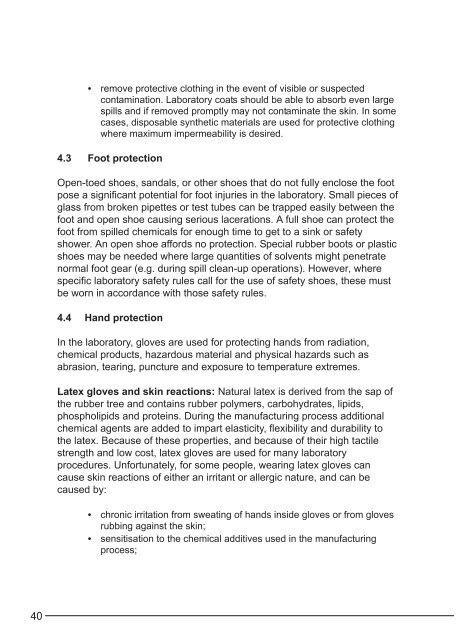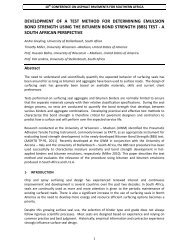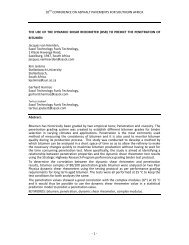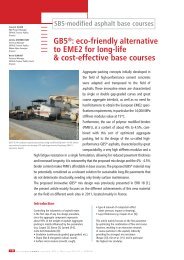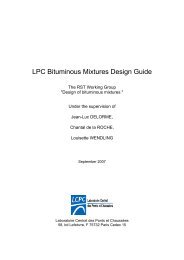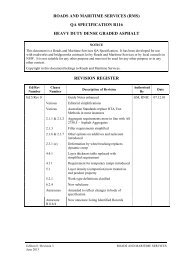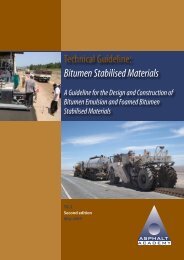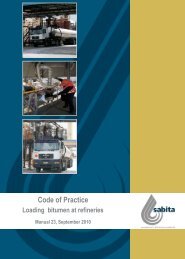Guide to the safe handling of solvents in a bituminous ... - Aapaq.org
Guide to the safe handling of solvents in a bituminous ... - Aapaq.org
Guide to the safe handling of solvents in a bituminous ... - Aapaq.org
- No tags were found...
Create successful ePaper yourself
Turn your PDF publications into a flip-book with our unique Google optimized e-Paper software.
• remove protective cloth<strong>in</strong>g <strong>in</strong> <strong>the</strong> event <strong>of</strong> visible or suspectedcontam<strong>in</strong>ation. Labora<strong>to</strong>ry coats should be able <strong>to</strong> absorb even largespills and if removed promptly may not contam<strong>in</strong>ate <strong>the</strong> sk<strong>in</strong>. In somecases, disposable syn<strong>the</strong>tic materials are used for protective cloth<strong>in</strong>gwhere maximum impermeability is desired.4.3 Foot protectionOpen-<strong>to</strong>ed shoes, sandals, or o<strong>the</strong>r shoes that do not fully enclose <strong>the</strong> footpose a significant potential for foot <strong>in</strong>juries <strong>in</strong> <strong>the</strong> labora<strong>to</strong>ry. Small pieces <strong>of</strong>glass from broken pipettes or test tubes can be trapped easily between <strong>the</strong>foot and open shoe caus<strong>in</strong>g serious lacerations. A full shoe can protect <strong>the</strong>foot from spilled chemicals for enough time <strong>to</strong> get <strong>to</strong> a s<strong>in</strong>k or <strong>safe</strong>tyshower. An open shoe affords no protection. Special rubber boots or plasticshoes may be needed where large quantities <strong>of</strong> <strong>solvents</strong> might penetratenormal foot gear (e.g. dur<strong>in</strong>g spill clean-up operations). However, wherespecific labora<strong>to</strong>ry <strong>safe</strong>ty rules call for <strong>the</strong> use <strong>of</strong> <strong>safe</strong>ty shoes, <strong>the</strong>se mustbe worn <strong>in</strong> accordance with those <strong>safe</strong>ty rules.4.4 Hand protectionIn <strong>the</strong> labora<strong>to</strong>ry, gloves are used for protect<strong>in</strong>g hands from radiation,chemical products, hazardous material and physical hazards such asabrasion, tear<strong>in</strong>g, puncture and exposure <strong>to</strong> temperature extremes.Latex gloves and sk<strong>in</strong> reactions: Natural latex is derived from <strong>the</strong> sap <strong>of</strong><strong>the</strong> rubber tree and conta<strong>in</strong>s rubber polymers, carbohydrates, lipids,phospholipids and prote<strong>in</strong>s. Dur<strong>in</strong>g <strong>the</strong> manufactur<strong>in</strong>g process additionalchemical agents are added <strong>to</strong> impart elasticity, flexibility and durability <strong>to</strong><strong>the</strong> latex. Because <strong>of</strong> <strong>the</strong>se properties, and because <strong>of</strong> <strong>the</strong>ir high tactilestrength and low cost, latex gloves are used for many labora<strong>to</strong>ryprocedures. Unfortunately, for some people, wear<strong>in</strong>g latex gloves cancause sk<strong>in</strong> reactions <strong>of</strong> ei<strong>the</strong>r an irritant or allergic nature, and can becaused by:• chronic irritation from sweat<strong>in</strong>g <strong>of</strong> hands <strong>in</strong>side gloves or from glovesrubb<strong>in</strong>g aga<strong>in</strong>st <strong>the</strong> sk<strong>in</strong>;• sensitisation <strong>to</strong> <strong>the</strong> chemical additives used <strong>in</strong> <strong>the</strong> manufactur<strong>in</strong>gprocess;40


